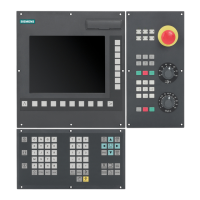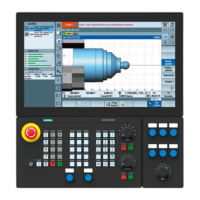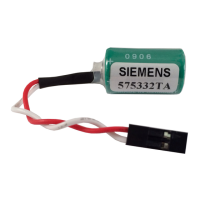Additional functions
13.6 Electronic gear (EG)
Job planning
13-26 Programming Manual, 03/2006 Edition, 6FC5398-2BP10-1BA0
Parameters
Variant 1:
FA Following axis
Block change mode The following modes can be used:
"NOC" block change takes place immediately
"FINE" block change is performed for "synchronism
fine"
"COARSE" block change is performed for "synchronism
coarse"
"IPOSTOP" block change is performed for setpoint-
based synchronism
LA1, ... LA5 Leading axes
Z1, ... Z5 Counter for coupling factor i
N1, ... N5 Denominator for coupling factor i
Coupling factor i = Counter i / Denominator i
Only the leading axes previously specified with the EGDEF command may be programmed in
the activation line. At least one leading axis must be programmed.
Variant 2:
FA Following axis
Block change mode The following modes can be used:
"NOC" block change takes place immediately
"FINE" block change is performed for "synchronism
fine"
"COARSE" block change is performed for "synchronism
coarse"
"IPOSTOP" block change is performed for setpoint-
based synchronism
[, LAi, SynPosLAi, Zi, Ni] (do not write the square brackets)
min. 1, max. 5 sequences of:
LA1, ... LA5 Leading axes
SynPosLAi Synchronized position for i-th leading axis
Z1, ... Z5 Counter for coupling factor i
N1, ... N5 Denominator for coupling factor i
Coupling factor i = Counter i / Denominator i
Only leading axes previously specified with the EGDEF command may be programmed in the
activation line. Through the programmed "Synchronized positions" for the following axis
(SynPosFA) and for the leading axes (SynPosLA), positions are defined for which the axis
grouping is interpreted as
synchronous
. If the electronic gear is not in the synchronized state
when the grouping is switched on, the following axis traverses to its defined synchronized
position.
Variant 3:
The parameters are the same as for variant 2 as regards:
Approach mode The following modes can be used:
"NTGT": Approach next tooth gap time-optimized
"NTGP" : Approach next tooth gap path-optimized
"ACN": Traverse rotary axis in negative direction
absolute
"ACP": Traverse rotary axis in positive direction
absolute
"DCT" Time-optimized with respect to programmed
synchronized position
"DCP" Path-optimized with respect to programmed
synchronized position

